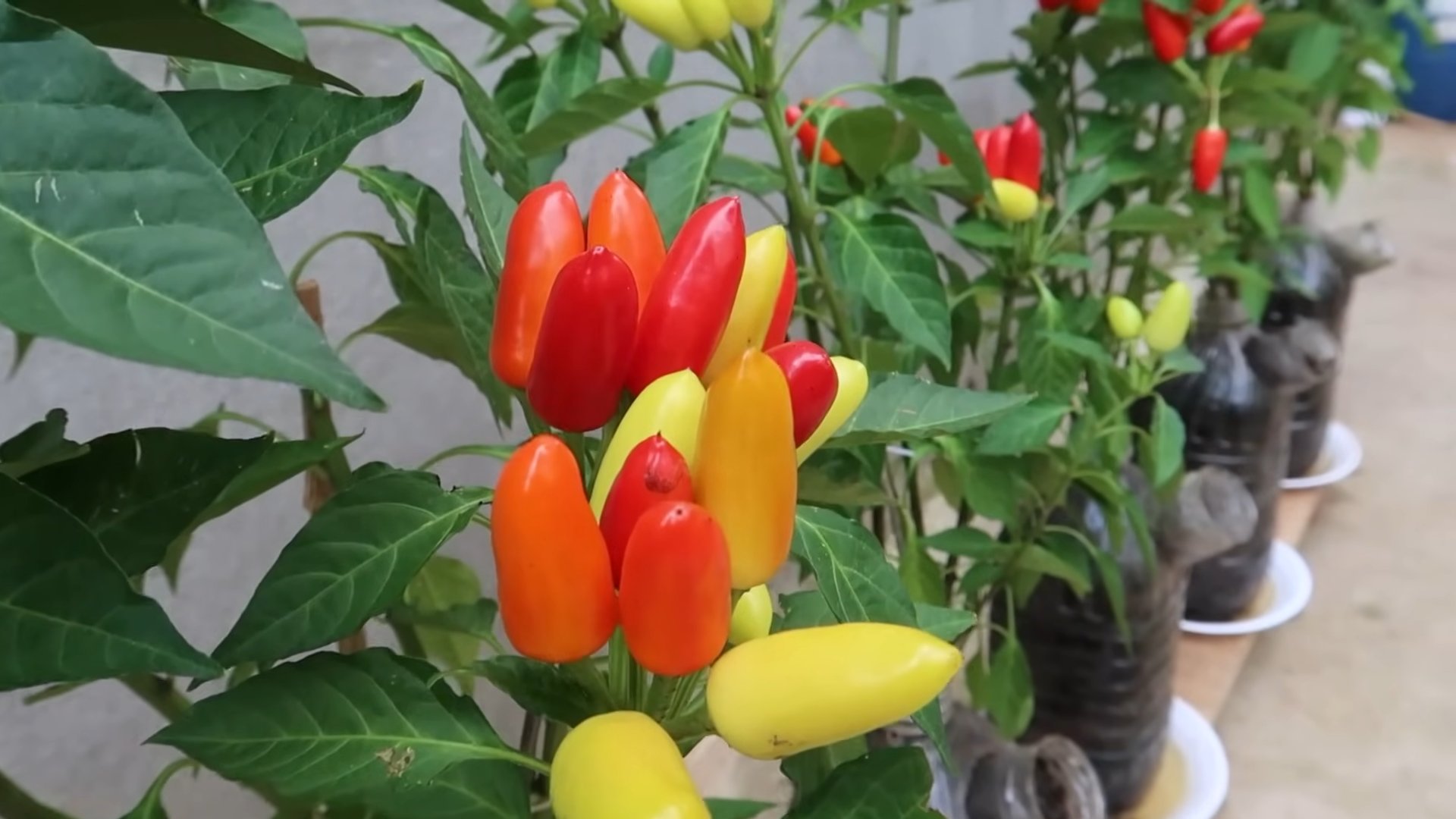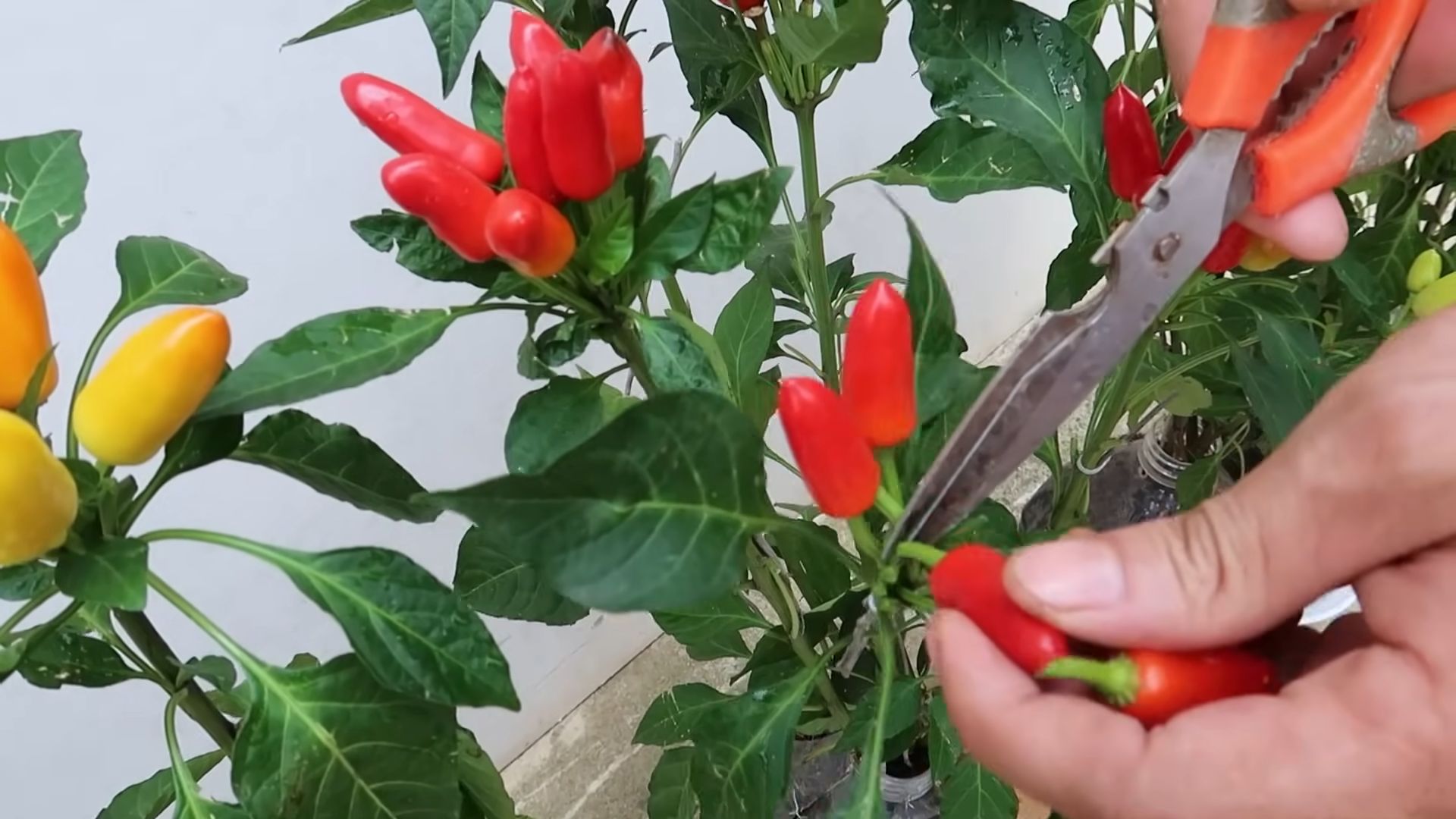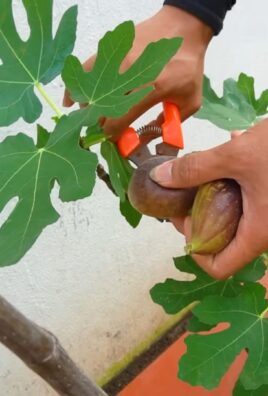Recycled Bottle Pepper Growing: Imagine biting into a juicy, homegrown pepper, bursting with flavor, knowing you nurtured it from seed to table – all while giving a plastic bottle a new lease on life! Sounds pretty amazing, right? Well, it’s totally achievable, even if you don’t have a sprawling garden. For centuries, resourceful gardeners have found innovative ways to cultivate food in limited spaces, from ancient rooftop gardens in Babylon to modern-day urban farms. This tradition of ingenuity continues with our focus today: transforming discarded plastic bottles into thriving pepper patches.
Why should you embrace recycled bottle pepper growing? Because it’s a win-win! You’re reducing waste, saving money, and enjoying the satisfaction of growing your own delicious peppers. Plus, it’s incredibly space-efficient, perfect for balconies, patios, or even a sunny windowsill. In today’s world, where sustainability and self-sufficiency are more important than ever, learning simple DIY tricks like this empowers us to take control of our food sources and contribute to a greener planet. I’m excited to share my favorite tips and tricks for successful recycled bottle pepper growing, so let’s get started!

DIY: Grow Peppers in Recycled Plastic Bottles!
Hey there, fellow gardening enthusiasts! I’m super excited to share one of my favorite DIY projects with you: growing peppers in recycled plastic bottles. It’s a fantastic way to reduce waste, save money, and enjoy fresh, homegrown peppers right at your fingertips. Plus, it’s surprisingly easy! Let’s dive in!
Materials You’ll Need
Before we get started, let’s gather all the necessary materials. Trust me, having everything ready beforehand will make the whole process much smoother.
* Plastic Bottles: The star of the show! I usually use 2-liter soda bottles or larger water bottles. Make sure they’re clean and free of any residue. The number of bottles depends on how many pepper plants you want to grow.
* Pepper Seeds or Seedlings: You can start from seeds or buy small pepper seedlings from your local nursery. I personally love starting from seeds, but seedlings will give you a head start. Choose your favorite pepper variety – bell peppers, jalapenos, habaneros, the possibilities are endless!
* Potting Soil: Use a good quality potting mix. Avoid garden soil, as it can be too heavy and doesn’t drain well in containers.
* Scissors or Utility Knife: For cutting the plastic bottles. Be careful!
* Drill or Nail and Hammer: To create drainage holes.
* Watering Can or Spray Bottle: For watering your pepper plants.
* Optional: Gravel or Small Rocks: To improve drainage at the bottom of the bottle.
* Optional: Plant Labels: To keep track of your pepper varieties.
* Optional: Gloves: To protect your hands.
Preparing the Plastic Bottles
This is where we transform those discarded bottles into mini-gardens!
1. Clean the Bottles: Thoroughly wash the plastic bottles with soap and water to remove any dirt, grime, or sugary residue. Rinse them well and let them dry completely. This is important to prevent mold or bacteria growth.
2. Cut the Bottles: Decide how you want to cut your bottles. There are a couple of options:
* Option 1: Single Container: Cut the bottle in half horizontally. You’ll use the bottom half as the container and discard the top half (or save it for another project!). This is the simplest method.
* Option 2: Self-Watering Container (My Favorite!): Cut the bottle about two-thirds of the way down. Invert the top portion and nest it inside the bottom portion. This creates a self-watering system where the roots can draw water from the bottom reservoir. This is a bit more advanced, but it’s worth the effort!
Important Safety Tip: When using scissors or a utility knife, always cut away from yourself and use a stable surface.
3. Create Drainage Holes: This is crucial for preventing waterlogging and root rot. If you’re using the single container method, drill or poke several drainage holes in the bottom of the bottle. If you’re using the self-watering method, drill or poke holes in the bottle cap of the inverted top portion. This will allow water to wick up into the soil.
4. Optional: Add Gravel: If you’re using the single container method, you can add a layer of gravel or small rocks to the bottom of the bottle to further improve drainage. This is especially helpful if you live in an area with heavy rainfall.
Planting Your Peppers
Now for the fun part – planting your pepper plants!
1. Fill with Potting Soil: Fill the prepared plastic bottle with high-quality potting soil. Leave about an inch or two of space at the top. If you’re using the self-watering method, fill the top portion with soil.
2. Plant the Seeds or Seedlings:
* From Seeds: Make a small indentation in the soil (about ¼ inch deep). Place 2-3 pepper seeds in each indentation and gently cover them with soil. Water lightly.
* From Seedlings: Gently remove the seedling from its container. Loosen the roots slightly. Dig a hole in the soil large enough to accommodate the root ball. Place the seedling in the hole and gently backfill with soil. Water thoroughly.
3. Water Thoroughly: After planting, water the soil thoroughly until water drains out of the drainage holes (if you’re using the single container method). If you’re using the self-watering method, fill the bottom reservoir with water.
4. Label Your Plants (Optional): If you’re growing multiple varieties of peppers, label each bottle with the pepper type and planting date. This will help you keep track of everything.
Caring for Your Pepper Plants
Proper care is essential for healthy and productive pepper plants.
1. Sunlight: Pepper plants need at least 6-8 hours of direct sunlight per day. Place your bottles in a sunny location, such as a windowsill, balcony, or patio. If you don’t have enough natural sunlight, you can supplement with grow lights.
2. Watering: Water your pepper plants regularly, especially during hot weather. Check the soil moisture by sticking your finger into the soil. If the top inch of soil feels dry, it’s time to water. Avoid overwatering, as this can lead to root rot. If you’re using the self-watering method, simply refill the bottom reservoir when it’s empty.
3. Fertilizing: Pepper plants are heavy feeders and benefit from regular fertilization. Use a balanced fertilizer (e.g., 10-10-10) or a fertilizer specifically formulated for vegetables. Follow the instructions on the fertilizer package. I like to use a liquid fertilizer diluted in water every 2-3 weeks.
4. Pruning: Pruning can help improve air circulation and encourage bushier growth. Remove any yellowing or dead leaves. You can also pinch off the tips of the branches to encourage more branching.
5. Pest Control: Keep an eye out for pests such as aphids, spider mites, and whiteflies. If you notice any pests, treat them with insecticidal soap or neem oil. You can also try hand-picking the pests off the plants.
6. Support: As your pepper plants grow, they may need support to prevent them from falling over. You can use stakes, trellises, or cages to support the plants.
Harvesting Your Peppers
The best part of growing your own peppers is harvesting them!
1. Harvest Time: Peppers are typically ready to harvest when they reach their mature size and color. The time to harvest will vary depending on the pepper variety. Bell peppers are usually harvested when they are green, red, yellow, or orange. Jalapenos are typically harvested when they are green, but they can also be harvested when they turn red.
2. Harvesting Technique: Use scissors or pruning shears to cut the peppers from the plant. Be careful not to damage the plant.
3. Enjoy Your Harvest: Use your homegrown peppers in your favorite recipes! You can eat them fresh, roast them, grill them, or pickle them.
Troubleshooting
Even with the best care, you might encounter some problems. Here are a few common issues and how to address them:
* Yellowing Leaves: This could be a sign of overwatering, underwatering, nutrient deficiency, or pest infestation. Check the soil moisture, fertilize the plants, and inspect for pests.
* Blossom End Rot: This is a condition where the bottom of the pepper turns black and rotten. It’s usually caused by a calcium deficiency. Add calcium to the soil or use a calcium-rich fertilizer.
* Lack of Fruit: This could be due to insufficient sunlight, poor pollination, or extreme temperatures. Make sure your plants are getting enough sunlight, hand-pollinate the flowers, and protect the plants from extreme temperatures.
* Pests: As mentioned earlier, keep an eye out for pests and treat them promptly.
Tips for Success
Here are a few extra tips to help you succeed with your recycled bottle pepper garden:
* Choose the Right Pepper Variety: Consider your climate and growing conditions when choosing pepper varieties. Some varieties are better suited for container gardening than others.
* Use High-Quality Potting Soil: Don’t skimp on the potting soil. Use a good quality potting mix that drains well and provides essential nutrients.
* Water Regularly: Consistent watering is crucial for healthy pepper plants.
* Fertilize Regularly: Pepper plants are heavy feeders and need regular fertilization.
* Provide Support: As your plants grow, they may need support to prevent them from falling over.
* Be Patient: Growing peppers takes time and patience. Don’t get discouraged if you don’t see results immediately.
Why I Love This DIY Project
I absolutely love this DIY project because it’s:
* Eco-Friendly: It reduces waste by repurposing plastic bottles.

Conclusion
So, there you have it! Transforming a humble recycled bottle into a thriving pepper garden is not just a fun project; it’s a sustainable, space-saving, and surprisingly effective way to cultivate your own delicious peppers. We’ve walked you through the simple steps, highlighting the benefits of this ingenious DIY trick. From reducing waste to enjoying fresh, homegrown produce, the advantages are undeniable.
Why is this a must-try? Because it empowers you to take control of your food source, even with limited space or resources. Imagine the satisfaction of harvesting vibrant, flavorful peppers that you nurtured from seedling to fruit, all within the confines of a repurposed plastic bottle. It’s a tangible connection to nature, a small step towards a more sustainable lifestyle, and a rewarding gardening experience all rolled into one. Plus, it’s a fantastic conversation starter!
But the beauty of this project lies in its adaptability. Feel free to experiment with different pepper varieties. From the fiery heat of habaneros to the sweet crunch of bell peppers, the possibilities are endless. You can also explore different soil mixtures to find what works best for your local climate and pepper type. Consider adding a slow-release fertilizer to the soil for an extra boost of nutrients.
For those seeking a more aesthetically pleasing setup, consider painting the bottles with vibrant colors or decorating them with creative designs. This not only adds a personal touch but also helps to protect the roots from excessive sunlight. You could even create a vertical garden by hanging multiple bottle planters on a wall or fence, maximizing your growing space and adding a touch of green to your surroundings.
Another variation involves incorporating a self-watering system. By adding a wick made of cotton rope or felt that extends from the soil down into a reservoir of water at the bottom of the bottle, you can ensure a consistent supply of moisture to the roots, reducing the need for frequent watering. This is particularly useful for those who live in hot, dry climates or who tend to forget to water their plants regularly.
The key to success with this **recycled bottle pepper growing** method is consistent care and attention. Regularly check the soil moisture, provide adequate sunlight, and protect your plants from pests and diseases. With a little effort, you’ll be rewarded with a bountiful harvest of delicious peppers that you can use in your favorite recipes.
We wholeheartedly encourage you to give this DIY project a try. It’s a simple, affordable, and incredibly rewarding way to grow your own peppers. Don’t be afraid to experiment, adapt, and personalize the process to suit your own needs and preferences.
And most importantly, we want to hear about your experience! Share your photos, tips, and stories with us in the comments section below. Let’s create a community of recycled bottle pepper growers and inspire others to embrace sustainable gardening practices. What pepper varieties did you choose? What challenges did you encounter, and how did you overcome them? Your insights could be invaluable to other aspiring gardeners. So, get your bottles ready, grab some seeds, and let’s start growing!
Frequently Asked Questions (FAQ)
1. What type of plastic bottle is best for growing peppers?
Ideally, you should use PET (polyethylene terephthalate) plastic bottles, which are commonly used for soda and water bottles. These are generally considered food-safe and durable. Avoid using bottles that have contained harsh chemicals or cleaning products. Make sure to thoroughly clean the bottle with soap and water before using it for planting. Also, consider the size of the bottle. Larger bottles (2-liter or larger) are generally better as they provide more room for the roots to grow.
2. What kind of soil should I use for my recycled bottle pepper garden?
A well-draining potting mix is essential for growing healthy peppers in recycled bottles. Avoid using garden soil, as it can become compacted and hinder drainage. A good potting mix should contain a blend of peat moss, perlite, and vermiculite. You can also add compost to enrich the soil with nutrients. Consider using a potting mix specifically formulated for vegetables, as these often contain added nutrients that are beneficial for pepper growth.
3. How much sunlight do my recycled bottle pepper plants need?
Peppers thrive in full sunlight, requiring at least 6-8 hours of direct sunlight per day. Place your recycled bottle pepper plants in a sunny location, such as a south-facing window or a sunny balcony. If you don’t have access to enough natural sunlight, you can supplement with grow lights. LED grow lights are a good option as they are energy-efficient and provide the necessary spectrum of light for plant growth.
4. How often should I water my recycled bottle pepper plants?
The frequency of watering will depend on the climate, the type of soil, and the size of the bottle. Generally, you should water your plants when the top inch of soil feels dry to the touch. Avoid overwatering, as this can lead to root rot. Make sure the bottle has drainage holes to allow excess water to escape. During hot weather, you may need to water your plants more frequently. Consider using a moisture meter to accurately gauge the moisture level of the soil.
5. How do I fertilize my recycled bottle pepper plants?
Peppers are heavy feeders and require regular fertilization to produce a bountiful harvest. You can use a balanced liquid fertilizer, such as a 10-10-10 or 20-20-20 formula, diluted to half strength. Fertilize your plants every 2-3 weeks during the growing season. You can also add slow-release fertilizer granules to the soil at planting time. Organic fertilizers, such as compost tea or fish emulsion, are also excellent options.
6. How do I protect my recycled bottle pepper plants from pests and diseases?
Regularly inspect your plants for signs of pests or diseases. Common pepper pests include aphids, spider mites, and whiteflies. You can control these pests with insecticidal soap or neem oil. Diseases such as powdery mildew and blossom end rot can also affect pepper plants. Ensure good air circulation around your plants to prevent fungal diseases. Blossom end rot is often caused by calcium deficiency, so you can add calcium to the soil or use a calcium-rich fertilizer.
7. Can I grow different types of peppers in recycled bottles?
Yes, you can grow a wide variety of peppers in recycled bottles, from sweet bell peppers to spicy chili peppers. Consider the size of the pepper plant when choosing a bottle size. Larger pepper varieties may require larger bottles. Also, be aware of the different growing requirements of different pepper varieties. Some peppers may require more heat or sunlight than others.
8. How do I transplant my pepper seedlings into the recycled bottle?
Gently remove the pepper seedling from its original container, being careful not to damage the roots. Create a hole in the soil in the recycled bottle that is large enough to accommodate the root ball. Place the seedling in the hole and gently backfill with soil. Water the seedling thoroughly after transplanting. Provide shade for the seedling for a few days to help it adjust to its new environment.
9. How long does it take for peppers to grow in recycled bottles?
The time it takes for peppers to grow will depend on the variety of pepper, the climate, and the growing conditions. Generally, it takes about 60-90 days from transplanting for peppers to mature. Sweet peppers typically mature faster than hot peppers. Provide your plants with adequate sunlight, water, and nutrients to ensure optimal growth.
10. What are some creative ways to decorate my recycled bottle pepper garden?
There are many creative ways to decorate your recycled bottle pepper garden. You can paint the bottles with vibrant colors, add decorative labels, or create a vertical garden by hanging the bottles on a wall or fence. You can also add decorative stones or mulch to the top of the soil. Get creative and personalize your recycled bottle pepper garden to reflect your own style.




Leave a Comment